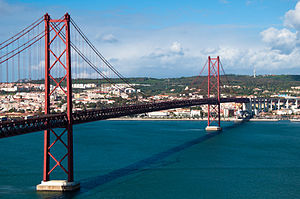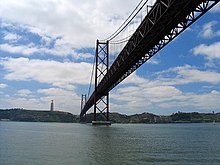Ponte 25 de April
Coordinates: 38 ° 41 ′ 23 " N , 9 ° 10 ′ 38" W.
| Ponte 25 de April | ||
|---|---|---|
| View over the Tejo from the Cristo Rei | ||
| use | Road traffic (6 lanes) Railway traffic |
|
| Crossing of | Tagus river | |
| place | Lisbon | |
| construction | Suspension bridge , double deck bridge | |
| overall length | 2277.64 m | |
| width | 30 m | |
| Longest span | 1012.88 m | |
| height | 190 m | |
| Clear height | 70 m | |
| start of building | 1962 | |
| completion | 1966 | |
| opening | August 6, 1966 | |
| location | ||
|
|
||
The Ponte 25 de Abril (German: Bridge of April 25 ) is a 3.2 kilometer long bridge in Portugal with a 2278 meter long suspension bridge over the Tagus . After the Yavuz Sultan Selim Bridge and the Tsing Ma Bridge , it is the third longest suspension bridge with combined road and rail traffic worldwide . It connects the Lisbon district of Alcântara with the city of Almada in a north-south direction . The A2 / IP7 motorway crosses the bridge in six lanes . It is simply called Ponte by the locals .
history
The first considerations about a connection to the south can be shown to go back to the late 19th century. In 1913 the government proposed a bridge construction from the Rocha Conde de Óbidos to Almada. These plans were taken up again in 1921 by the Spanish civil engineer Peña Boeuf . He achieved that his proposal was heard and discussed in the Portuguese Parliament, while in 1929 the Portuguese civil engineer António Belo favored a rail link between the Lisbon district of Beato and Montijo . Following these initiatives, Duarte Pacheco , the minister responsible for public buildings, set up a first commission in 1933. The results presented in 1934 ultimately led to the construction of the bridge in the northeast at Vila Franca de Xira .
It was not until 1953 that a further commission was commissioned by the government to work out or examine corresponding plans which, in turn, should enable both rail and road transport. In 1958 the commission recommended a bridge connection from the south bank of Lisbon to the Cristo-Rei . With the following public tender, in which four companies participated, a consortium led by the American steel company US Steel emerged as the winner (US Steel had already presented plans for this in 1935 and now used plans from the office of David B. Steinman ). Construction was carried out by the American Bridge Company , supported by eleven other local companies.
Construction began on November 5, 1962. The steel required was imported from the United States. Of the 3,000 or so workers on the construction site, four lost their lives. When it was completed in August 1966, around 2.2 million man-hours were required, whereby the planned construction time was undercut by six months.
In a state act in the presence of the highest government representatives such as President Admiral Américo Tomás , Prime Minister António de Oliveira Salazar and the Cardinal of Lisbon Manuel Gonçalves Cerejeira, the bridge was inaugurated on August 6, 1966 under the name Salazar Bridge and presented to the public. After the Carnation Revolution of April 25, 1974, it was renamed Ponte 25 de Abril .
When it was built, it was planned to add a railway deck with two tracks. This was only realized between 1996 and 1999 under the carriageway slab together with the widening of two lanes. For this purpose, two new cables were installed above the two existing suspension cables, which were anchored in new external anchor blocks. The extension was approved on June 30, 1999, and since then the Ponte 25 de Abril has been part of the Linha do Sul . The tender for the Eixo Norte / Sul was won by the private rail operator Fertagus, which has since offered regional trains between Lisbon and Coina or Setúbal . The state CP has only been crossing the bridge since 2004, and only in long-distance traffic in the direction of the Alentejo and Algarve . The bridge is only used by passenger trains, freight trains from north to south use the Linha de Vendas Novas , which merges into the Linha do Alentejo in Vendas Novas, while this then flows into the Linha do Sul in Funcheira.
The bridge has served as the starting point for the Lisbon half marathon once a year since 1991 .
construction
The main opening of the Ponte 25 de Abril has a span of 1012.88 m, the two side openings of 482.42 m each. Together with a connection opening on the south side with a span of 98.64 m and two connection openings on the north side with 98.64 m each, this results in a length of 2275.64 m for the steel suspension bridge. The foreland bridge on the north bank of the Tejo, a prestressed concrete construction , has a length of around 937 m with spans of up to 76 m. The two main pillars of the suspension bridge are 190 m high and are founded 82 m below sea level. The height of the lanes over the water is 70 m.
Costs / toll
The construction costs at that time amounted to around 2.2 billion Escudos or 32 million US $ (converted to 2006 this would correspond to around 201 million US dollars). The bridge was to be financed through toll revenues for 20 years. After this time, the bridge should be reduced or even exempt from tolls; this was not implemented by a government decision. The announcement of the increase in tolls from 100 to 150 Escudos on June 14, 1994 led to serious protests against the government around Cavaco Silva in the following days . A demonstration on June 25, 1995 resulted in riots, injuries and a bridge closure of over 12 hours. The increase was intended to avoid public funding for the construction of the Ponte Vasco da Gama . For this purpose, the private consortium Lusoponte was granted a license to collect tolls for both bridges for a period of 40 years.
The toll was initially charged in both directions - since 1993, this has only been required in Almada for the south-north direction (towards the city):
traffic
In 2006, at peak times, over 7,000 road vehicles crossed the bridge every hour; an average of around 150,000 road vehicles and around 160 rail vehicles per day. A total of around 390,000 people use the building every day.
Comparison with similar bridges
Due to the color of the paintwork and the lattice-like stiffening girder, the Ponte 25 de Abril looks at first glance similar to the Golden Gate Bridge in San Francisco . However, the striking pylons are not stiffened in the transverse direction by horizontal bars, but by diagonal, crossing bars. In addition, most of the dimensions of the Ponte 25 de Abril are smaller. The actual model is the two-story San Francisco Bay Bridge , which was also built by the American Bridge Company, but was built in the 1930s. The Forth Road Bridge in Edinburgh can be described as a sister bridge because its pylons and stiffening beams are constructed very similarly and it was built at the same time.
Tejob back in Lisbon
The Ponte 25 de Abril is, besides the Ponte Vasco da Gama, the only bridge that directly connects the metropolis with the south or east side of the Tagus. The construction of a third bridge connection has been discussed since 2007. Tunneling under the Tagus is also being considered. The connection is to be established between Barreiro and Beato and then also include an express train connection from Madrid to Lisbon.
Trivia
The Ponte 25 de Abril has been used as the setting in numerous films, including the 1969 James Bond series On Her Majesty's Secret Service .
literature
- Alfons Emge, Saizhong He: Tejo Bridge Lisbon Extension . In: Stahlbau 67 , year 1998, issue 12, pp. 891–901.
Individual evidence
- ↑ Ponte 25 de Abril - Taxas ( pt ) lusoponte.pt. Archived from the original on January 29, 2013. Info: The archive link was inserted automatically and has not yet been checked. Please check the original and archive link according to the instructions and then remove this notice. Retrieved February 11, 2013.
- ↑ TV documentary broadcast on August 6, 2006 on the Portuguese TV channel RTP1








